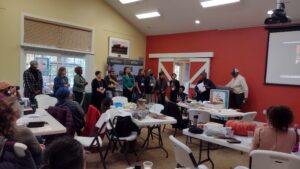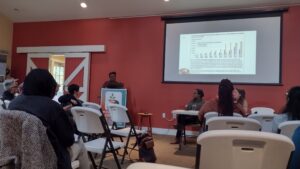Final report for LNE22-456R
Project Information
Most seeds grown in Northeastern farms and gardens are not sourced regionally. As a result, many seeds are not adapted to regional environmental conditions, and crop production does not often match the cultural acceptability of food among the region’s diverse populations. Although Northeastern seed growers do produce locally adapted seeds, many of which have cultural importance, most of these growers remain disconnected from one another and formal market opportunities, hindering the stewardship of regionally adapted culturally meaningful (CM) seeds. BIPOC growers in particular are crucial stewards of CM seed in the Northeast but often lack access to the necessary resources to enter markets and meet consumer demand.
This project supported the Ujamaa Cooperative Farming Alliance (UCFA), a collective of BIPOC seed growers, to enhance the market viability of regionally adapted CM seed in the Northeast. Based on lessons from the Global South, where value chain development initiatives have successfully linked smallholders growing CM crops to competitive market opportunities, this project adapted the Participatory Market Chain Approach to identify market opportunities for UCFA seed growers and cultivate coordination with other Northeastern seed value chain entities (i.e., seed companies, farmers, gardeners) and those further downstream interested in end products (fruits, vegetables, etc.) originating from CM seeds (specialty grocers, restaurants, wholesalers). Specific objectives were to (a) ascertain the opportunities and barriers to marketing CM seeds, (b) determine UCFA growers’ position to take advantage of market opportunities, (c) assess Northeastern seed consumers and other end-users’ demand for CM seeds to inform marketing strategies, and (d) build capacity of UCFA to take advantage of identified opportunities.
Using a participatory mixed-methods approach, this project was driven by the perspective, priorities, and action of UCFA members who have shown significant interest in selling CM seed. In collaboration with University of Vermont (UVM), UCFA seed growers led the research approach and activities of this project. Qualitative data were collected through focus groups representing critical segments in the Northeastern seed value chain to inform the development of a survey that comprehensively assessed various stakeholder perspectives, with focus on farmers and gardeners, regarding the opportunities for and challenges to marketing CM seed in the region.
The research findings point to both challenges and opportunities to amplify the supply of CM seed in the seed value chain. One of the primary issues that will need to be addressed is scale of production. Most seed growers interested in cultivating CM varieties operate at very small scales and are often disconnected from markets, translating to difficulty in providing a consistent supply to seed companies. In addition, other segments of the the value chain, primarily seed companies and specialty grocers, acknowledge the need to identify culturally sensitive and appropriate marketing and advertising strategies. However, low levels of interaction across the value chain, especially in the connections that farmers and gardeners have with others in the value chain, hinder the capacity for the value chain to address these issues. Despite these challenges, stakeholders across the value chain indicated an interest in increasing their options for culturally meaningful crops for their customers and recognized, as they did so, the importance of higher levels of engagement with farmers and gardeners who cultivate CM varieties to foster understanding and develop collaboration. Thus, our findings provide empirical evidence that potential exists to grow a market niche for CM crops but will need to address critical challenges for success. These findings have been made publicly available in a summary report (https://scholarworks.uvm.edu/calsfac/206/) and have been presented at conferences including of the Agriculture, Food, and Human Values Society and the Rural Sociological Society. The research team will continue to analyze the data and disseminate the findings, with focus turning to peer-reviewed manuscripts.
This project will support the Ujamaa Cooperative Farming Alliance (UCFA), a collective of BIPOC seed growers, to enhance the market viability of Northeastern adapted, culturally meaningful (CM) seed. The specific objectives are to (a) ascertain the opportunities and barriers to marketing CM seeds, (b) determine UCFA growers’ position to leverage market opportunities, (c) assess Northeastern end users’ demand for CM seeds, and (d) build the capacity of UCFA to take advantage of identified opportunities. These objectives support Northeastern BIPOC growers benefitting from an emerging market while enhancing climate resilience, food security, and equity in the regional food system.
In the Northeastern United States (US), most seeds that farmers and gardeners grow are not sourced regionally. As a result, the region is not self-sufficient in producing seeds, perhaps the most important input to crop-based production systems. Sourcing seeds from elsewhere has serious implications for food system resilience: seeds not adapted to regional environmental conditions are often more vulnerable to extreme weather events; seed supply is more volatile as demonstrated by seed companies’ struggles to fulfill orders amidst the Covid-19 pandemic when consumer demand rose; and crop production does not match the cultural acceptability of food among diverse populations, a core but often overlooked component of food security.
A diverse array of individual seed growers in the region produce regionally adapted seeds, many of which have important cultural meaning. However, most of these growers are disconnected from one another and formal market opportunities, hindering the stewardship of regionally adapted CM seeds. Although BIPOC growers are especially important stewards of CM seed, they often lack access to the necessary resources to meet market demand and are thus motivated by cultural reasons with little other incentive. The importance of CM seeds to the region was made clear during 2021’s Northeast Organic Seed Growers Conference (NOGSC), attended by 387 seed growers who articulated the need to raise awareness about the cultural attributes of seeds, as well as address material and technical limitations to their production and marketing.
The Ujamaa Cooperative Farming Alliance (UCFA), a project incubated by the non-profit Steam Onward in 2019, seeks to bolster the availability and accessibility of CM seed. Envisioned as a “collective of emergent and seasoned growers who cultivate heirloom seeds and grow culturally relevant plants for food, healing, and textiles,” the mission of UCFA includes explicit recognition that there is “need for increased diversity in farming and the seed industry, and the need to provide more opportunities and support for growers from historically oppressed and marginalized communities.” UCFA is thus building a business model that views seed not just as a commodity but also as a vessel of cultural heritage, individual and community narratives, culinary importance, and knowledge and education.
The mission of UCFA builds upon emerging evidence that cultural components of crop production is of growing interest to farmers and gardeners. For example, at the 2021 NOGSC, 387 individuals participated (2019 NOGSC attendance: 70 individuals). Participants discussed the cultural ties that seed provides, especially for BIPOC growers. A post-conference survey (n=115) provided reinforcement of these priorities: 99.07% (107 of 108 respondents) indicated they were interested or very interested in pursuing connections with seed growers of different races/ethnicities and 87.50% (84 of 96 respondents) in learning about issues of power and justice in the food system. Research conducted specifically in Vermont provided further indication of regional interest in the environmental and cultural aspects of agriculture. Unpublished data from the 2021 Vermonter Poll (annual representative Vermont household survey; n=636) indicated that among those who grow crops for food (50.8%), 74.2% identified seeds being adapted to Vermont’s growing conditions and 38.6% having cultural significance as important. Similarly, Baxley et al. (2020) found that among 151 Vermont seed growers, cultural motives like connecting to nature (M=4.48 of 5.0; n=143) and preserving traditional agricultural practices (M=4.11 of 5.0; n=134) were among the most important motivations to produce seeds (https://scholarworks.uvm.edu/calsfac/97/).
Over the last three decades, many small seed companies have appeared throughout the Northeast and greater United States selling a range of crop varieties. However, these seeds are often treated primarily as agricultural inputs, with little attention to their cultural importance. Therefore, CM seeds are not easily accessible for growers and consumers who seek specific crop varieties that serve as important cultural connections to their diverse heritages. However, successful models do exist of how to identify and leverage market opportunities for agricultural products embedded with cultural value. Cases in the Global South, where impoverished smallholder farmers have successfully linked CM crop varieties to competitive market opportunities, highlight the need to understand perspectives across the value chain, with particular emphasis on farmers’ assets and barriers. This project adhered to these lessons from the Global South, seeking a clear understanding of how UCFA seed growers could best capture growing interest among seed companies and other end-users (farmers/gardeners, wholesalers, grocers, restaurants) while maintaining cultural integrity.
Given the gap that exists regarding if and how culture is perceived by seed value chain stakeholders and how it can be leveraged to amplify supply and demand for CM crop varieties, this project assessed the perspectives of stakeholders across the value chain: seed growers, farmers and gardeners, seed companies, distributors and processors, food retailers, and restaurants. Through focus groups and survey research, this project documented perceptions regrading the challenges, bottlenecks, and opportunities to growing and distributing CM seeds and crops. A comprehensive value chain perspective not only accounted for the issues that each set of stakeholders confront but also addressed the dynamics between stakeholder groups.
Cooperators
- (Researcher)
- (Researcher)
- (Researcher)
Research
Given that this study is exploratory (the nature of value chain analyses), the research questions driving this project primarily focus on discovering and describing the current conditions, future opportunities, and likely challenges to marketing regionally adapted CM seed:
- What market opportunities and barriers for CM seeds exist for UCFA seed growers among various downstream (end-user) market actors (seed companies, farmers and gardeners, wholesalers, farmers and gardeners, grocers, and restaurants)?
- How are UCFA seed growers positioned to take advantage of identified market opportunities?
- What outreach is necessary to provide UCFA members with the tools to create successful marketing strategies?
The first phase of this project focused on qualitative data collection through focus groups with different actors in the Northeastern seed value chain. As outlined in the proposal, our goal was to complete six focus groups by November 2022, which was achieved on November 8, 2022. The six focus groups focused on: Ujamaa seed growers (n=4), seed companies (n=6), non-Ujamaa farmers and gardeners (n=3), restaurant chefs (n=8), food distributors (n=4), and specialty grocers (n=4). Each of the focus groups lasted 60-90 minutes and was conducted remotely via Microsoft Teams. The focus groups were recorded and transcribed, and the research team (made up of both UVM and Ujamaa personnel) collaboratively engaged in qualitative analysis, which informed survey development.
Farmers were highly involved in the project activities. Farmers consistently engaged in important ways. The three Ujamaa members who helped lead this project all grow culturally important seeds and the five additional Ujamaa members who were part of the research team are likewise Ujamaa growers. One of those researcher-farmers facilitated all 6 of the focus groups and was accompanied by another Ujamaa team lead (to take notes) and one UVM individual (serving as tech support). We decided to prioritize an Ujamaa member as the focus group facilitator in order to a) ensure that Ujamaa is the face of the project to the degree possible and b) to ensure that the focus group was steered by someone whose lived experiences as a BIPOC grower could identify important leads and conversation strands useful to Ujamaa. To prepare the Ujamaa researchers for focus group facilitation, UVM provided training on focus groups to the Ujamaa research team, which included a power point presentation, additional resources, and exercises for practice.
In Year 2, our attention was primarily dedicated to the analysis of qualitative data and survey data collection. Qualitative analysis continued, with one Ujamaa and one UVM research working in collaboration, which led to a robust and rigorous methodological process, by which important discussions about experiences and identities biasing data interpretation and purpose of data analysis were had.
Using preliminary insights from the focus groups, UVM and Ujamaa researchers began to develop a survey in February 2023. Beginning in April, the PI and an Ujamaa researcher would meet virtually to construct the survey. This collaborative process meant that progress was slow but that each question - and the organization of them - was considered carefully. During survey development, Ujamaa and UVM researchers were consulted consistently. During survey development, we opted to develop a single survey (as opposed to two as was originally proposed), given that the functionality of the survey platform we were using (Qualtrics) provided the ability for us to develop common questions across all stakeholder groups as well as specific modules to which respondents could be filtered into based on their value chain position. In total, the survey had two common sections (one on preferences and priorities for seed and food and one on demographics) and four distinct modules (one for farmers and gardeners, one for Ujamaa growers only, one for seed companies, and one for downstream value chain stakeholders (processors, distributors, retailers, restaurants, etc.)).
In July 2023, the survey was field tested by a group of 8 individuals representing various stakeholder groups (seed growers, farmers/gardeners, chefs/restaurants, grocers, seed companies). Upon incorporating feedback, the survey was again field-tested in September 2023 to assess survey functionality in Qualtrics. Recruitment began in early October 2023 by both Ujamaa and UVM. Two main methods were used for recruitment. Key organizational contacts (i.e., NOFAs, Master Gardeners, Black farmer associations, etc.) were contacted to see if they would be willing to distribute the survey recruitment email in their listservs and/or within newsletters. In addition, a contact list had been compiled through internet research of seed companies, restaurants, wholesalers/food distributors, and grocers and the survey recruitment email was sent directly to them. Focus initially exclusively focused on the Northeast. Early success receiving several hundred responses in the beginning weeks, primarily among farmers and gardeners in the Northeast, compelled us to focus more attention to other seed value chain stakeholders (chefs, grocers, etc.) and expand our scope geographically (recognizing that seed networks are not often geographically bound and that a broader geographic focus would illuminate and contextualize the activities within the Northeast to a greater degree).
Survey data collection continued until January 2024. When the survey closed, we had 1,753 valid responses, of which 1,160 were from gardeners and 425 were from farmers. In addition, we received responses from 72 seed company representatives, 10 seed retailers, and 76 downstream businesses. Among the 1,370 respondents who answered the question about geographic representation, 338 came from the Northeast, including 287 farmers and gardeners, 17 seed company representatives, and 32 downstream business representatives.
Our methodological approach of a value chain analysis, by which we focus on opportunities and barriers for different actors in the seed value chain, has generated rich and robust data. Though we are still processing the data, several interesting findings have emerged related to the barriers and opportunities for culturally meaningful seed and Ujamaa's position to take advantage of the emerging market opportunity.
Cultural meaning as a seed/food trait was found to be important among respondents, though not as important as other qualities. Although sourcing seeds from a farm maintaining CM crops was the least important characteristic among respondents, 66% of respondents still indicated that it was either somewhat or very important, suggesting that while it may not be the highest priority among respondents relative to other farm characteristics, it nonetheless may contribute to their decision-making about what to source and from where. Similarly, when asked about how various seed characteristics influenced preferences for food, respondents overwhelmingly indicated that seeds were most important to food quality, with all other response options lagging far behind in terms of respondent preferences. Still, over 50% of respondents indicated that the connections between seeds and place as well as family traditions were either very important or important, suggesting that elements of cultural meaning are relevant. Based on the data, we found that seed/food traits that were consistently ranked the highest were local, sustainable, non-GMO, flavor, and quality. Thus, focusing on flavor, quality profiles, local/regional origin, and non-GMO as important complements to cultural meaning must be incorporated into production to encourage marketing opportunities and consumption of CM seeds and foods.
Culturally appropriate marketing was found to be difficult for seed companies but less so for downstream seed-to-food value chain stakeholders like grocers. In both the quantitative and qualitative indicated that seed companies experience wariness about bringing culturally meaningful seeds to market. As one seed company representative reflected in a focus group, "“…there's some varieties that I don't think have ever been sold in a big seed company way, at least. And I definitely don't want [my seed company] to be the ones always bringing new varieties like that to a market. [It] feels exploitative and, yeah, not our place…it's just tricky constantly.” On the other hand, downstream businesses reported less challenge with selling culturally meaningful food in a culturally respectful way, with 47% indicating it was very or moderately challenging compared to 61% of seed companies. Fostering connections between these groups (and other seed-to-food value chain stakeholders such as farmers and gardeners) could help businesses develop culturally sensitive strategies, while also encouraging connections across the value chain in such a way that would help close the gap that exists between the upstream and downstream segments. Building capacity to advertise and market culturally meaningful food and seeds is particularly important, given the growing interest among seed companies and downstream businesses indicated in amplifying their supply. When seed companies were asked about their inventory of culturally meaningful seeds, responses indicate that the majority of seed companies in our sample are already selling them (67%), and of the 23% that are not currently selling CM seeds, 71% of these companies are interested in beginning to sell them. Among the downstream value chain stakeholders respondents, 55% of businesses indicated that they offered CM products. Of the 25% that do not currently offer CM foods, 80% of these businesses indicated they would like to begin offering these foods. The existing offerings of CM seed and food, coupled with the growing interest, suggests that cultural meaning can emerge as an important characteristic in the niche market.
However, challenges do exist in ramping up the culturally meaningful seed and food supply, with supply uncertainties constituting one of most difficult. Our findings indicate that CM seed producers are often operating on small plots of land and producing limited amounts of CM seeds. These results may help explain why farmers, gardeners, seed companies/retailers, and downstream stakeholders reported that they lack a consistent and adequate supply of CM seeds and crops. Furthermore, considering that 66% of respondents self-identified as gardeners, it is likely that CM seed is being produced by many growers on limited scales and who are not currently connected to markets. The barrier of scale emerged as an important theme as well in focus groups. As one seed company representative noted, "And one [challenge] is just trying to figure out how to make growing a small quantity of seed worthwhile for a grower, I find really hard. I mean, [my seed company] sells a wide variety of quantities for what we need for inventory for a year. But some things are really small in ounces. And people who are growing them for us are doing a lot of work, even if it’s a small amount of row feet and they’re making less than $100, which is truly like a, it’s not a source of income. So, that’s a challenge."
While challenges no doubt exist, so too do opportunities. Given the importance of close coordination across the value chain to develop a niche market, we asked each stakeholder group about their connections with others in the value chain. Farmers and gardeners were least connected to other value chain stakeholders, with 50% or more respondents indicating they were somewhat or very connected to only 3 of the 11 groups (growers, consumers, seed companies, community-based organizations/non-profits, retailers, researchers/academics, chefs/restaurants, advocacy groups, food distributors, policymakers/government officials, food processors). Although both seed companies and downstream businesses were better connected, with 50% or more indicating connection to 7 of 11 groups and 8 of 11 groups respectively, our findings nonetheless indicate that gaps across the value chain exist, particularly between upstream stakeholders (those whose activities are most relevant to seeds) and downstream stakeholders (those whose activities are most relevant to food). However, survey respondents roundly indicated desire to strengthen their connections with others along the chain, with particular interest among seed companies and downstream businesses to connect with farmers and gardeners of culturally meaningful seed. When asked what would be most helpful to increase the supply of culturally meaningful seed, 87% of downstream businesses and 82% of seed company representatives identified more interaction with growers of culturally meaningful crops as helpful, the highest priority for both sets of stakeholders.
Our findings also point to opportunities on the production end of the seed value chain. As one of our project's objectives was to support Ujamaa in its programmatic activities moving forward, we filtered farmers and gardeners who either have sold seed through Ujamaa or are interested in doing so to better understand their needs. We found that the highest priority areas for trainings revolved around best seed growing practices, choosing seeds well-adapted to local climates, harvesting/processing seeds, controlling for pests and diseases, enhancing production efficiency, and storing seed. In addition, these farmers and gardeners indicated a need for business support services, as well as more access to material resources, including land and tools for production and seed processing.
Based on our findings, we are able to conclude that while potential exists to amplify the supply of culturally meaningful seed and food, attention will need to be dedicated to specific value chain components as well as the entire value chain.
Given that cultural meaning was a characteristic that was relatively less important to survey respondents than others (i.e., sustainability, organic, etc.), concerted efforts to raise the awareness of how culture is embedded in seeds and food and why it's important will be necessary moving forward. Indeed, our research participants also indicated that consumers also lack familiarity with culturally meaningful seed/food, serving as a barrier to market potential. Seed companies perceived that many of their consumers may not know how to grow CM seed. Both growers of CM crops and downstream stakeholder groups noted that they often dedicate their growing/purchasing food products to those familiar to their customers. Educating consumers and launching public awareness campaigns highlighting that culturally meaningful means a particular seed or food is important to a cultural group and each consumer has a food culture or unique preference are necessary focal points to address apprehension about culturally meaningful seeds.
Enhanced connectivity among value chain stakeholders also constitutes and important priority for the future. As has been successful in other parts of the world seeking to develop niche markets, multi-stakeholder partnerships will be necessary to pool resources, coordinate activities, and develop collective efforts to enhance interest in and capacity to grow the culturally meaningful seed (and food) market. Based on the results from this study, specific areas to focus on include seed companies and downstream businesses better understanding the challenges and constraints of farmers and gardeners as well as interaction among stakeholders to inform culturally sensitive advertising and marketing of culturally meaningful seeds. Multi-stakeholder partnerships can also pursue strategies to alleviate some of the resource and technical constraints experienced by farmers and gardeners. Collective efforts to enhance access to seed processing tools, for example, is the kind of initiative that has been successfully pursued in value chain development in the Global South. In addition, based on our findings, Ujamaa and other organizations have specific guidance regarding the topics that seed producers have articulated as most needed.
However, not all challenges to the culturally meaningful seed value chain are likely to be addressed by the stakeholders directly working with the seed and food. Additional engagement will be necessary from policymakers to address significant barriers like land constraints. Without the capacity to scale up production, the value chain will confront the ongoing challenge of supply uncertainties. Thus, multi-stakeholder partnerships must be public-private in nature, such that public entities like the government and universities support private and community-based efforts. When transparent and inclusive public-private partnerships are established, value chain development is more likely to achieve success.
Education & outreach activities and participation summary
Educational activities:
Participation summary:
In Year 1, UVM personnel developed two trainings for Ujamaa researchers: one on focus groups and how to conduct them (Focus groups Training) and the other on qualitative data analysis (Qual Training_11.18.2022). These slide decks were provided to Ujamaa researchers but were also presented during online meetings.
In late October 2022, this project contributed to the two-day Sorghum Festival Ujamaa coordinated and executed. Held in Accoceek, MD, this two-day event attracted ~50 individuals, most of whom were Ujamaa members. The two-day event included several informational sessions on agrobiodiversity, seed saving, seed cleaning, sorghum processing, etc. A brief (~15 minute) update was presented to attendees about the project. Photos of the two-day event may be found here: 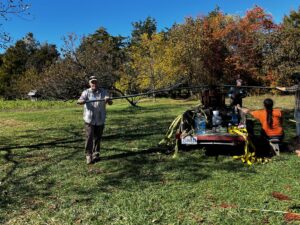
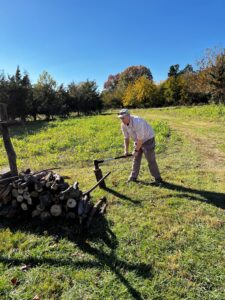

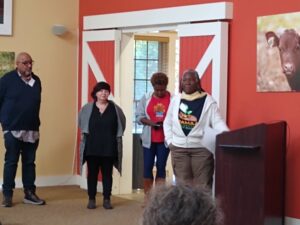
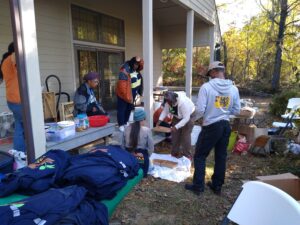
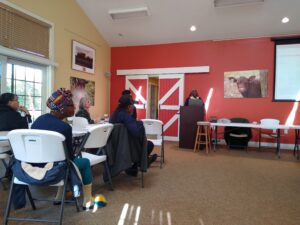
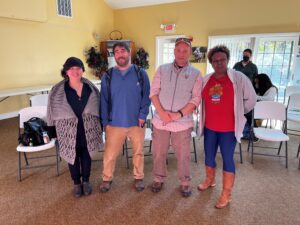
In Year 2, UVM personnel attended two workshop events with Ujamaa and partners: one in Kentucky and one in October (again the Sorghum Festival). At both meetings, visioning exercises, analysis of organizational progress, and discussion about this project and the research that will emerge were discussed. These convenings were attended by Ujamaa growers, federal agency representatives, seed companies, non-profits, Extension educators, and university researchers. Below are a few pictures from the Sorghum Festival in Accoceek, MD.
In addition, our team presented two collaborative conference presentations, one at the Agriculture, Food, and Human Values Society (AFHVS) conference in June in Boston, MA, and the other at the Rural Sociological Society (RSS) conference in August in Burlington, VT. The AFHVS presentation included a collaborative presentation, by which two Ujamaa researchers and two UVM representatives co-presented. At RSS, a UVM graduate student presented, with embedded video from Ujamaa researchers. Slide decks for the two presentation are included under Informational Products.
In June 2023, the three primary grant partners from Ujamaa and one Ujamaa researcher traveled to Vermont where they expanded their networks. Their meetings included UVM administrative leaders (CALS Dean, Associate Dean, and Director of the Food Systems Research Center), New Farms for New Americans program staff in the Association for African Living in Vermont, High Mowing Organic Seeds, and seed growers engaged in the Upper Valley Seed Savers.
In Year 3, our team presented at two academic conferences, one at the Agriculture and Human Values Conference in Syracuse, NY and the other at the Rural Sociological Society meeting in Madison, WI. The slide decks are uploaded in Informational Products.
Once we completed collecting survey responses, we dedicated the subsequent months to drafting and finalizing summary reports of the data. We developed two summary reports: the first was a comprehensive report that covered all survey questions (except for questions related to Ujamaa growers) that we disseminated back out to survey respondents and other networks. We decided to develop a second brief report focused on Ujamaa growers for Ujamaa Cooperative Farming Alliance specifically, as we decided those responses were more relevant organizationally than to the entirety of the seed value chain. Both reports are uploaded in Informational products.
We are currently working on additional outputs from this project. One conference abstract has been submitted for consideration for the Agriculture and Human Values conference that will be held in Corvallis, OR in June 2025. In addition, we currently have two manuscripts in progress that we plan to submit for peer review in the coming months.
Learning Outcomes
Our trainings for Ujamaa leaders and researchers are the activities that have most obviously affected knowledge, attitudes, skills, and/or awareness. Although no formal data collection has been conducted to assess gains, informal comments from Ujamaa partners have suggested that they have learned about the research process, qualitative analysis, budget management, and university collaborations, among other topics. Designed as a project that builds the capacity of Ujamaa to conduct applied research projects, the success that Ujamaa collaborators have had in successfully facilitating focus groups and engaging in the qualitative analysis process points to considerable increases in knowledge and skills.
In Year 2, training continued to be intensive for Ujamaa members. In particular, one of the Ujamaa researchers has gained extensive experience and skills in qualitative data analysis through her serving as one of the two primary coders. In addition, one Ujamaa researcher has gained survey development skills through her consistent engagement in the process of survey construction. All Ujamaa researchers have learned about and participated in the survey recruitment process, including considerations of IRB process and stipulations.
Educational outcomes continued through the process of data analysis and the writing up of results. Our regular meetings between UVM and Ujamaa continued throughout the project, such that once we had data to analyze, we collectively discussed and decided the approach. During the process of writing up the summary reports, Ujamaa collaborators were consulted repeatedly for edits and revisions. Two Ujamaa collaborators provided significant suggestions to assure that the language and message were relevant to the Ujamaa community and other public stakeholders.
Our collaborative activities continue as we proceed with data analysis to prepare peer-reviewed manuscripts. Ujamaa collaborators have been and will continue to engage in the process of drafting academic articles, the first time that several have participated in such an activity.
Project Outcomes
One of the important outcomes of this project has been the network building. As a participatory, collaborative endeavor, this project relied on strong relationships that have provided new avenues for applied research. Not only did this project provide new potential collaborative opportunities with organizations in geographically diverse regions, including an emerging partnership with the Organic Seed Alliance, but also reinvigorated local collaborations with the New Farms for New Americans program and High Mowing Organic Seeds.
The primary theme undergirding this project - the embeddedness of culture in seed - has begun to provide the necessary momentum for the development of applied research projects. We recently completed a UVM internal grant with the Institute for Agroecology based on participatory plant breeding for sorghum and mung bean - two culturally meaningful crops - with growers across the country. We also have been collaborating with the newly formed Climate Kitchen Institute at UVM to conduct sensory evaluations of various mung bean varieties with the local Bhutanese Nepali population that we aim to eventually grow into a participatory plant breeding and short value chain project.
Student successes have also emerged from this project. The data generated from this project provided the basis of two M.S. theses successfully completed in 2024. In addition, one of the primary project partners from Ujamaa, Alexis Yamashita, enrolled in the UVM Food Systems Ph.D. program in Fall 2024 and will orient her research around culturally meaningful seed and value chain development.
This project was designed as a highly collaborative, participatory one. To that end, we structured its management in such a way that demanded time and energy. The leadership teams at Ujamaa and UVM met every other week, meetings among UVM personnel occurred every other week, and ad hoc meetings were scheduled as necessary with Ujamaa researchers to prepare and/or navigate current research activities. This approach was time consuming and did not allow for rapid decision-making, but was effective in developing trust and rapport and allowing space for disagreements to be worked through. As the project progressed, maintaining this degree of momentum was difficult. With Ujamaa as a relatively new and growing organization with many initiatives, time became increasingly scarce and though we were able to maintain consistency in our meetings, participation by individuals varied. We were, however, able to navigate this challenge by complementing our regular meetings with other forms of communication such as text threads and phone calls. In sum, it became clear to the project team that a high participatory project as this one will need to revisit its rhythm and time demands during different phases of the project.
From a data collection perspective, we were very pleased with the number of survey responses we received. Our initial success in the Northeast prompted us to (with consent from Northeast SARE) to expand data collection geographically to capture dynamics and trends nationally, something we were able to accomplish, particularly among farmers and gardeners. However, we did experience challenges recruiting other stakeholders, especially downstream businesses like processors, distributors, and restaurants. Despite our efforts, the lack of supporting organizations and listservs targeting these populations made it difficult to access these individuals and we thus had to rely on cold emails for recruitment, a method that yielded limited success. To enhance research participation among these groups, long-term investments in cultivating relationships, including attending industry conferences, is likely necessary. In a similar vein, our representation of BIPOC individuals in data collection was not as robust as we would have liked. Our hope that Ujamaa's reputation and networks with BIPOC communities still met headwinds; as Ujamaa leadership explained, many BIPOC farmers and other food system actors feel deep skepticism in participating in research activities, given their historical experiences with public universities and government agencies. We made concerted efforts to interact with organizations supporting BIPOC individuals, especially farmers and gardeners, and though several were keen to support our recruitment efforts, many others did not engage. This suggest broader systemic issues that will be necessary to address for BIPOC communities to see the value and engage in research, including universities and government agencies build trust in a transparent manner. Despite the challenges we encountered, we still did receive 338 responses from BIPOC individuals (22.6%), which is sufficient for comparative analysis.
Importantly, this project points to endeavors for future research. Our findings establish culture as an important characteristic of seeds and foods valued by many food system stakeholders, but one that is sensitive and requires careful and deliberate work to amplify. For market opportunities to develop that benefit producers and consumers who feel connection to particular crops and foods, value chain development will need to occur that focuses on building trust, rapport, and coordination across the value chain. Stakeholders who engage in value chain development for culturally meaningful seeds and foods must commit to viewing seeds and food not just as market commodities but as material that carry non-economic value as well, which holds implications for how these products are advertised and sold. Fortunately, frameworks exist that have been successfully carried out in the Global South to develop niche markets for culturally meaningful crops, and these can provide useful structure to guide future activities to pursue further development of the value chain for culturally meaningful seed and food.
Information Products
- Focus Group Training
- Qualitative Analysis Training
- Culturally meaningful seed: Navigating the complexities around accessibility, sustainability, and marketability in seed value chains in the Northeastern United States
- Market niches for culturally meaningful seed in the Northeastern US: A seed value chain analysis to encourage accessibility
- Who can innovate? Assessing growers’ capacities to introduce culturally meaningful seed into the US seed system
- Culturally Meaningful Seeds: Understanding Culturally Meaningful Seed Adoption and Potential for Growth
- Market Opportunities for Culturally Meaningful Seed and Food: 2023-2024 Stakeholder Summary Report
- Market Opportunities for Culturally Meaningful Seed and Food 2023-24 Stakeholder Summary Report – Ujamaa Cooperative Farming Alliance Grower Supplement
